Last Updated on January 21, 2024 by Greg Gillson
You saw a striking bird with a red head, did you? You wonder what it is. That shouldn’t be too hard to figure out, should it? How many kinds of birds with red heads could there possibly be?
In the United States and Canada there are many birds with either fully or partially red heads. Sometimes there is just a touch of red. Sometimes the entire bird is mostly red. Sometimes the red color is more orange, sometimes it is pinker.
List of 17 Birds with red heads
- House Finch
- Purple Finch
- Cassin’s Finch
- Red Crossbill
- Pine Grosbeak
- Northern Cardinal
- Pyrrhuloxia
- Summer Tanager
- Western Tanager
- Scarlet Tanager
- Vermilion Flycatcher
- Red-headed Woodpecker
- Red-breasted Sapsucker
- Pileated Woodpecker
- Red-bellied Woodpecker
- Acorn Woodpecker
- Downy Woodpecker
If you saw a bird with a red head at your backyard feeder, the options go way down. In fact, at least 90% of the time you are likely inquiring about the common House Finch. But there are other possibilities. This list isn’t all of the birds with red on its head, but it is a list of the most common birds with red heads you are likely to see in your backyard. And some of them, like the Downy Woodpecker, only have a small patch of red, others like the Summer Tanager, are red all over.
Finches
Finches love seeds, so, they are likely to show up at your backyard seed feeders. Finches are brown streaky sparrow-like birds, more likely in your trees than on the ground. It is only the adult males that show color. So, in a flock of red finches only a few of the birds will show a red head.
There are more than one kind of red headed finch. In fact, in the United States there are 3 red headed finches. Finches are similar to sparrows, so some people ask if there are red headed sparrows, when asking about these birds. In general, sparrows tend to feed on the ground and finches in trees.
1. House Finch
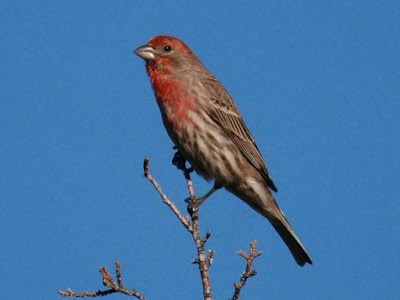 |
| House Finch Photo by Greg Gillson |
This is it! If you saw several small streaky gray-brown birds, some with bright reddish-orange forehead, breast, and rump at your seed feeder, this is probably your bird. Most birds are a reddish orange, some can be yellow, but the underlying pattern is the same.
House Finches are found in residential areas, towns, farms throughout the United States. They are only missing from the grasslands of the Great Plains and from most of Florida. They barely reach southern Canada. They are residents, meaning they don’t migrate for the most part, rather stay year-round in the same area.
They give chirping calls and sing throughout the year with a wiry warble with scratchy notes at the end.
2. Purple Finch
 |
| Purple Finch Photo by Greg Gillson |
Purple Finches don’t have the streaked flanks of House Finches. The male birds have a pinkish cast, especially on the top of the crown (the House Finch has a red forehead and brown crown). They have a forked tail.
Purple Finches live in damper woods and conifer forests. They are found in summer across southern Canada, barely reaching the northern tier of the United States in the Midwest and New England states.
They are also found in the mountains of the West, clear south to southern California. In winter they move out of Canada and are found throughout the Eastern US.
They have a rollicking warbled song with three identical quick rolling phrases, ending with two short notes, without the harsh ending noted of House Finches. I think the song of the western form sounds like “hurry little, hurry little, hurry little, hup! hup!” They also give a sharp dry “plic!” call in flight.
They may visit your seed feeder in winter.
3. Cassin’s Finch
 |
| Cassin’s Finch Photo by Greg Gillson |
In the drier mountain ponderosa pine forests of the West lives the Cassin’s Finch.
Males are very softly brushed with pink. The crown of the head is the brightest red. Note a thin white eye ring and deeply forked tail.
As with most finches they eat mostly seeds.
They give a 3-part call “tee-dee-yip” call and have a long song. The song lacks the harsh notes of House Finch and is less structured than Purple Finch.
4. Red Crossbill
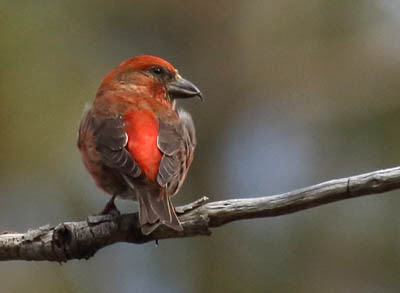 |
| Red Crossbill Photo by Greg Gillson |
Red Crossbills live in conifer forests. They are found from southern Alaska, across Canada, in the northern Midwest and New England states, in a few places in the Appalachians. They are widespread in the West, through the mountains of Mexico to middle America.
Crossbills sometimes irrupt in winter, moving in huge numbers from one area to another as the cone crops fail or are abundant locally. They may show up at backyard feeders well outside or south of their typical range, but mostly feed on pinecone seeds.
Males are red; females are yellowish. Birds with large crossed bills feed on the seeds of big pinecones. Birds with dainty bills feed on tiny soft spruce cones.
More than 10 forms of Red Crossbills have been “discovered” recently. They all have different songs and call notes. They have different size of bills and tend to feed on the cone seeds of different species of conifers. But they overlap in range in a confusing manner that scientists are still trying to figure out.
Red Crossbills have a warbling song similar to the finches above and give a doubled “kip-kip” or “jiff-jiff” call.
5. Pine Grosbeak
 |
| Pine Grosbeak Photo by Greg Gillson |
This large plump finch lives in conifer forests in Alaska and across Canada. In winter it barely makes it the northern tier of US states.
Different forms show quite a bit of variation in the amount of coloring–red on males, yellow on females. Otherwise, they are about 9 inches long, plump, with two white wing bars, a heavy black conical bill and forked tail.
They eat seeds, fruit and buds in winter. They are especially fond of the fruit clusters of mountain ash trees.
They sing a warbling song and give a flight call of “pui pui pui.”
Cardinals
If you see a crested bird with a red head and short conical bill at your seed feeder it is going to be one of the cardinals. They are larger than the finches.
6. Northern Cardinal
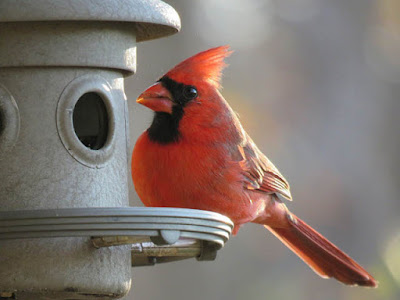 |
| Northern Cardinal Image by GeorgeB2 from Pixabay |
One of the most well-known feeder birds in the Eastern United States is the Northern Cardinal. They also occur from Texas to Arizona and south into Mexico. They are found in woodlands, thickets, and gardens. A form also lives in the desert Southwest.
Males are brilliant red throughout with a black face and bib. Females are buffier and duller, but still show some red.
Cardinals eat insects, fruit, and seeds. They readily come to backyard feeders and eat a wide variety of seeds and other bird foods.
Both sexes sing nearly year-round. Common whistled phrases include “cheery cheery cheery.”
7. Pyrrhuloxia
 |
| Pyrrhuloxia Uploaded by berichard, CC BY 2.0, Link |
Males of this gray desert cardinal have red patches on face, crest, breast, wings and tail. Females lack red. The thick conical bill is an obvious mark.
This species is found from Texas to Arizona and south into Mexico. They live in mesquite thickets and other thorny brush.
Pyrrhuloxias feed on the ground and eat weed seeds and other hard seeds.
They sing a liquid whistles song and have a metallic “chink” call.
Tanagers
Tanagers eat mostly insects, including bees, wasps, and beetles. They also eat fruit and berries. They migrate to Middle America for the winter. Bills are fairly heavy, but not as short and conical as seed eaters such as finches, sparrows, and cardinals.
8. Summer Tanager
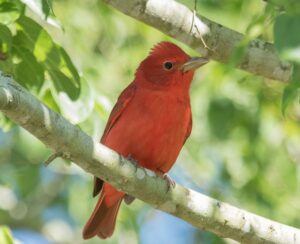 |
| Summer Tanager Photo by Imogen Warren |
Male Summer Tanagers stay bright red all year round. Females are much paler, tending toward yellowish with a red wash. The bill is pale. Another similar species, Hepatic Tanager, is found in mountain forests of the Southwest and has a black bill.
These birds are found in pine-oak woods in the East, but in cottonwoods in the West (see photo above).
They are found in the East from about Virginia to Iowa and south, west from Texas to southern California and into Mexico. They migrate out of the US in winter, except for a few in southern coastal regions from Florida to Texas and southern California.
They sing robin-like phrases and give a “ki-ti-tuk” call.
9. Scarlet Tanager
 |
| Scarlet Tanager Image by Steve Maslowski, Fish & Wildlife Service. Public domain. |
Males are red in breeding plumage but in fall and winter molt into a greenish plumage similar to the female. Males have deep black wings and tail. The bill is smaller than other tanagers.
They summer in deciduous woods in the eastern United States and migrate south out of the country in winter.
They sing hoarse robin-like phrases. Call is “chip-burr.”
10. Western Tanager
 |
| Western Tanager Photo by Greg Gillson |
Males in summer sport red heads on this bright yellow and black tanager.
They are found in the West, from northern Canada barely to Mexico in summer. They winter in Middle America.
These tanagers may appear in fall at backyard bird feeders. But as with all the tanagers, may be attracted to birdbaths and fountains year-round.
They sing a hoarse robin-like song and have clicking calls “pit-er-ick.”
Flycatchers
Most flycatchers are olive-green. There is one, however, that has a red head. Most flycatchers sit quietly for long periods on an exposed perch. Then they sally out to snap up a flying insect and return.
11. Vermilion Flycatcher
 |
| Vermilion Flycatcher Photo by Greg Gillson |
This small bird of the desert Southwest is a hurt-your-eyes red. Females are grayer above, white below with streaks on the breast and peach-colored on the lower belly. They are found throughout Mexico. In winter they disperse from California to Florida.
Even though they are desert birds they are usually found near stream sides. Typical manmade habitats they favor include golf courses, ball fields, cemeteries.
In breeding season the males sing their song in a fluttery display flight “pi-a-see pit-a-see.”
Woodpeckers
Male woodpeckers of most species have red on the head–some much more than others. They are frequently seen propping themselves up on the trunk of a tree as they search for insects in the bark or drilling into trees.
12. Red-headed Woodpecker
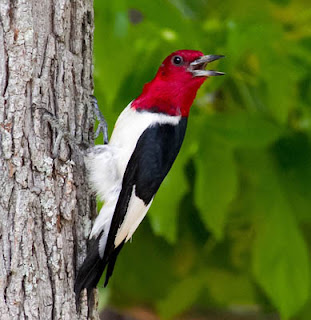 |
| Red-headed Woodpecker Image by Pixabay. |
This striking woodpecker is black and white with a red head.
It is found in most of the East and farms and streamside woods in the Great Plains.
They require trees big enough to drill their nest holes, and away from competition for those holes with European Starlings.
They eat flying insects they catch in the air or find other invertebrate prey, nuts, and seeds on the ground.
Their call is a soft rattle.
13. Red-breasted Sapsucker
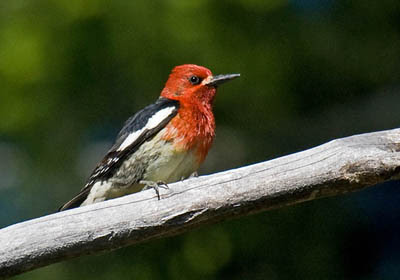 |
| Red-breasted Sapsucker Photo by Greg Gillson |
This uniquely named woodpecker is found on the West Coast from Alaska to southern California.
It prefers mixed woods or deciduous trees in conifer woods for nesting. In winter many descend from mountains to lowlands orchards and backyards.
They drill tiny rows of sap wells in trees and then visit them to drink the sap and eat any insects that were trapped in the sticky sap.
They aren’t very active, but give themselves away by their periodic wheezy descending calls.
14. Pileated Woodpecker
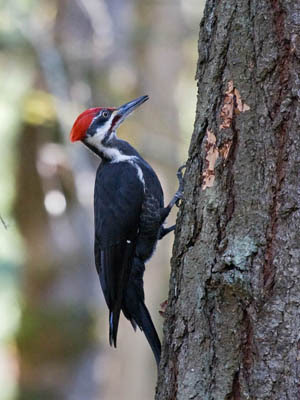 |
| Pileated Woodpecker Photo by Greg Gillson |
This huge black-and-white woodpecker with the flaming red crest is crow-sized and unforgettable. This species is found in eastern woodlands, across Canada, and in western mountains.
They prefer mature forests and deep woodlands, both deciduous and conifer.
They drill huge square holes in dead stumps and downed trees to excavate carpenter ants for food. They are one of only a few woodpeckers that will drill their nest cavities into firm live trees.
The loud wild call is a sign you are in the wilderness forests, a ringing “kik-kik, kik-kik, kik….”
15. Red-bellied Woodpecker
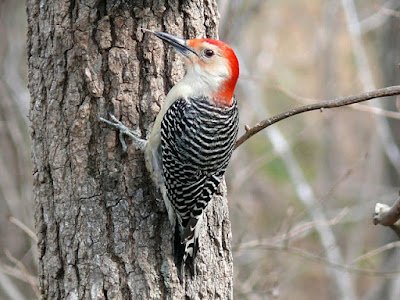 |
| Red-bellied Woodpecker Image by skeeze from Pixabay |
There are several similar species of black-and-white barred woodpeckers. Red-bellied Woodpeckers are one of the most common backyard birds in the Eastern United States. They live in woodlands and urban areas.
They readily come to backyard bird feeders. They eat suet, peanuts, and sometimes sunflower seeds. Their “wild” food consists of beetles, grasshoppers, and ants.
A common call is a rolling “churr.”
16. Acorn Woodpecker
 |
| Acorn Woodpecker Photo by Greg Gillson |
This black and white woodpecker with clown-like face and red crown is common in California and nearby areas of the Southwest.
They are found wherever there are groves of large oak trees, including pine-oak woodlands.
They live in large family groups and small colonies where they collect and store acorns tightly into the bark of trees. As the acorns dry they shrink and may fall out. So they are constantly testing the fit and moving acorns into better-sized holes. Granary trees can contain many thousands of acorns. They eat these acorns in winter. They also eat insects, frequently flying insects they catch in the air.
These are social and noisy birds, constantly calling “Whack-up! Whack-up!”
17. Downy Woodpecker
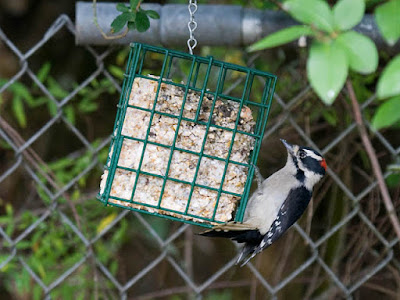 |
| Downy Woodpecker Photo by Greg Gillson |
The Downy Woodpecker is a tiny bird. They are common in backyards across the United States, Canada, and Alaska.
Only the males have a red spot on the back of the head. This is a frequent pattern for woodpeckers around the world. Only a few species have red heads, many types of larger woodpeckers do have red crests, though.
The bill is tiny on this bird compared to other woodpeckers. Thus, they tend to pick for beetles, ants, and other bark insects, rather than drilling for food. They are especially fond of suet at backyard feeders.
They give a sharp “pik!” call and in spring “sing” a longer descending whinny call, composed of a very rapid series of those “pik!” calls.
Hummingbirds
Male hummingbirds have iridescent throats that show red, orange, purple, and pink highlights. There is only one species of hummingbird regularly found in the eastern United States. There are 6 species of hummingbirds throughout most of the western United States. Southeast Arizona, though, is the US capitol for hummingbirds. There are 15 species of hummingbirds that occur in the United States each year. Of the 130 species of hummingbirds in the world (only in the Americas), a total of about 26 have occurred north of Mexico.
18. Anna’s Hummingbird
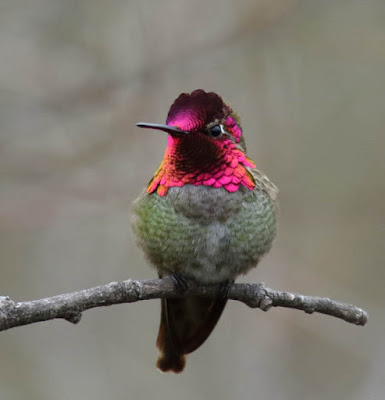 |
| Anna’s Hummingbird Photo by Greg Gillson |
In the United States hummingbirds mostly have red throats. In the desert southwest Costa’s Hummingbirds have a purple throat and crown while Anna’s Hummingbirds have a pinkish-red throat and crown.
Anna’s Hummingbirds are a common bird of California that have expanded in recent years into Oregon (even a few to SE Alaska) and Arizona. In winter they are found throughout the Baja peninsula and occasionally to Texas.
They eat flower nectar and insects they catch in flight or glean from plants. They take over hummingbird feeders but the tiny Rufous and Allen’s Hummingbirds can sometimes stand up to these larger bullies.
Males in spring (winter even!) start singing a long buzzy insect-like refrain from an exposed perch.
Why birds with red heads are special
Red head color in birds can be linked to various adaptations. For instance, the bright red crest of a cardinal might be used for attracting mates or defending territory. Many red-headed birds, like hummingbirds and tanagers, play crucial roles in plant pollination, contributing to the health and diversity of ecosystems.
Red-headed birds have often held symbolic meaning across cultures. From the firebird of Slavic folklore to the cardinal representing passion and joy in North America, their appearance has captured human imagination for centuries. There really is something special about birds with red heads.
Frequently Asked Questions
What causes feathers to be colored red?
The vibrant red we see in some birds can be attributed to two main factors: pigments and structure.
Carotenoids: These are yellow or orange pigments found in the food birds eat, like fruits, insects, and certain plants. Most birds can’t create their own red pigments, but some have a special ability to modify these dietary carotenoids into reddish hues known as ketocarotenoids. This conversion is thanks to a specific enzyme called CYP2J19, often referred to as the “redness gene.”
Feather structure: The way feather structures interact with light plays a crucial role in their perceived color. Tiny air pockets within the feathers can scatter and reflect light in specific ways, intensifying or modifying the color of underlying pigments. For example, red feathers might have microscopic ridges that enhance the red reflection while suppressing other colors.
Is there a Red Cardinal in Hawai’i?
The Red-crested Cardinal (Paroaria coronata) is an introduced species in Hawai’i, but not a true cardinal in the biological sense. It belongs to the tanager family and is sometimes called the Brazilian Cardinal. Males have a striking appearance with a red head and crest, contrasting against their grey wings and white underbelly. They are commonly found near beaches and parks.
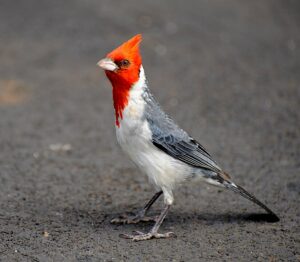
Photo by რობერტ (Robert)
What does it mean if you see a Scarlet Tanager?
The vibrant red plumage of the scarlet tanager is often associated with passion, enthusiasm, and new beginnings. Seeing one could be interpreted as a sign of hope for the future, personal growth, or positive change.
What is the most common red bird?
The Northern Cardinal is the most common bird with a red head. It is very common in backyards and loves to eat from feeders. It is mostly found on the eastern side of the United States but can also be found in the mid-West and all the way down through Central America.
Related:
Little brown birds at the feeder
What kind of birds have red eyes?
What kind of birds are yellow and black?
Learn about the 7 different kinds of bird feeders and the different birds they attract.
How to identify birds: 7 Steps to accurately identify birds



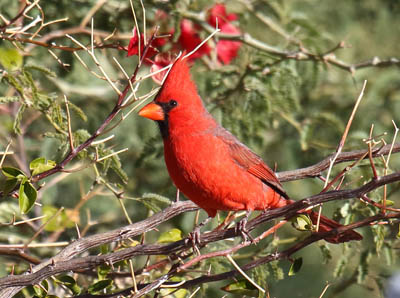
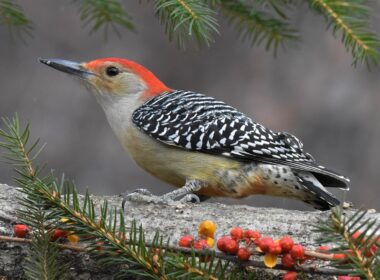
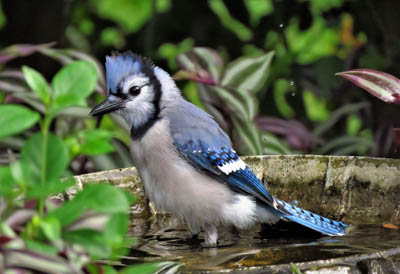
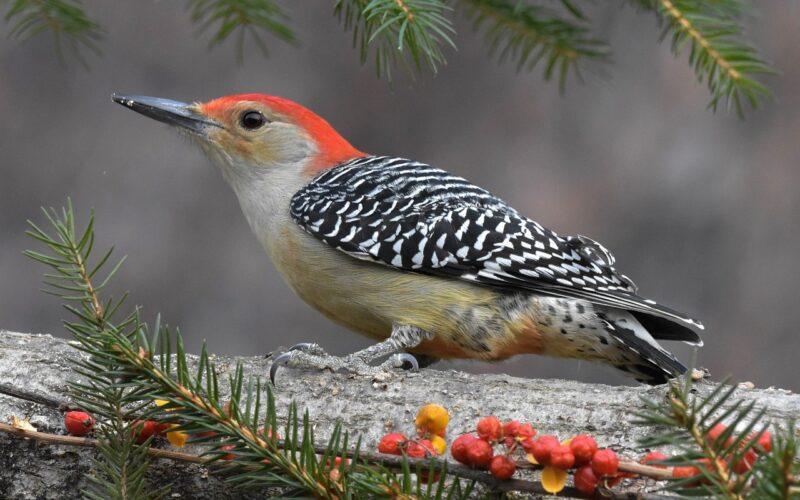
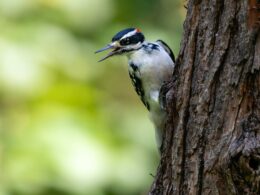
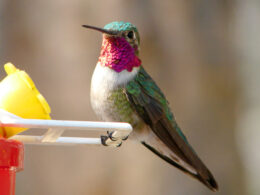
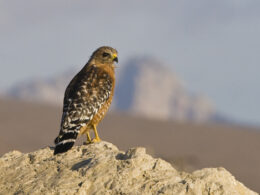
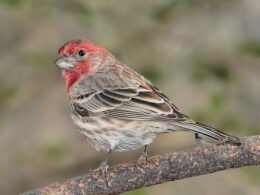
This comment has been removed by the author.
I like your comment section – no hassles and plenty of options. One can preview, edit, delete, go back to the post and decide to comment again, outside of Google, needing only to tick a box to prove that one is not a robot. And though the typing section is narrow, the comment is finally published in large and clear type. Am I mistaken, or don't many sites have the full package, like this one?
I came here looking for the ID of a small, brown, red-headed bird, a flock of whom I came upon for the first time in a park near where I live, in Sydney. I am not sure what it is I saw because the birds are always hiding or flying away. Looking at their shape, size and behaviour, I am leaning towards a finch, but I am not sure.
What I am sure of, after visiting your site, is that I have never seen a pileated woodpecker, LOL! Thank you for mentioning that it's crow-sized, a fact that I have never come across before, though I have been researching woodpeckers for quite a while now! It's funny how often the experts leave out the most striking feature of an individual while laying out its ID for us, just as some chefs forget to mention the most unique ingredient of a dish!
I guess that's okay, for why must one expect EVERYTHING for free?
Thank you for providing pictures of all the birds you have described! They are VERY useful, indeed.
Thank you for your detailed comment. I get woken every morning by Pileated Woodpeckers now that I have moved into the woods in Washington State! In San Diego it was House Finches and Mockingbirds! So different.
Sydney? Nova Scotia? Florida?
Thank you for your kind words (though I don't have much choice or control of the operation of the comment section).
first saw house finches in the 7s or 80s. not very many. by the 90s they were everywhere, but the house sparrows were disappearing. i heard pet stores
called them fire finches and had to set them free as it is illegal to sell wild birds.
Thanks for your comments!
Look up "Hollywood Finches" for their history.
Thank you for your post! I wanted to clarify if I just saw a red-headed woodpecker at our bird feeder…..and I did. First time with snow and a bird feeder in our back yard. I have binoculars and with Covid, it has been great fun and a new hobby for us.
I live in NE Ohio
Wonderful! So glad you are enjoying your new hobby.
Thanks for this resource! I just spent a while trying to identify a bird my dad took a picture of (I don't know much about birds). I almost decided it was a finch, but it's chest is fully gray/white with no red. Then I found a photo of a chipping sparrow that looks very similar to it. We live in southern Ontario.
In your area Chipping Sparrows should be summer birds, but not winter.
Could it be American Tree Sparrow?
But check House Sparrows again–both male and female–as they are abundant year-round residents in cities and backyards.
We observed a larger bird a pair actually we thought they were flickers and look exactly like that with the black neck ring and black spots on brown belly exactly like flickers but had lots of bright red on top of the heads not cheeks can’t find any other birds that look like it in our books so could we have a variant here in our woods in Kentucky
Dear Lamjcats7,
Thanks for your question.
Flickers in Kentucky have bright yellow wing and tail linings when they fly. The males do have a small spot of red on the back of the head. They often feed on ants on the ground.
However, another woodpecker with more red on the head is Yellow-bellied Sapsucker. They also have a black crescent on the chest. You may see them in orchards or other trees. They aren't as active as flickers.
Is the Cassin's Finch significantly smaller than a sparrow? I live in eastern Nebraska, and today was the first sighting at the feeder. Generally I get cardinals & sparrows.
No, the Cassin's Finch is about the same size as a sparrow. Cassin's live in ponderosa pine mountain forests and are very rare in Nebraska.
House Finch is also the same size as sparrow. This is most likely based on abundance and habitat.
However, northern Nebraska regularly gets Common Redpolls in winter. In some winters they come even farther south to Kansas. These are goldfinch-sized, so indeed, much smaller than sparrows. They are found in weedy fields, road edges, birch trees.
I really enjoyed this site. Will be visiting on a regular basis.Great information….
Thank you for your kind words, Linadazzo!
Hi found a lot of good information here
Thank you.
Wonderful sure
Wonderful sure
Wonderful insightful site
Thanks!
have a bird that looks exactly like a morning dove except it has a bump on its head. Any ideas as to what it is.
As unexciting as it may be, it sounds like a Mourning Dove with a bump on its head!
What is the life spam of Palliated Woodpeckers?
Banded Pileated Woodpeckers have been recaptured after at least 7 years. One wild bird was 9 years old when it died. Some in captivity have lived 10 years.
Hi, Greg
I am watching a couple of birds building the nest on my tree! This is so interesting and the first experience for me to see it. One (Maybe female?) is bringing a piece of grass or weed to make their nest and the other one is watching and the nest making bird flew away then the other one followed one repeatedly. So I was wondering what kind of birds they are and found your info. They are House Finch. I want to report that this finch lay eggs because she stays in the nest now.
Wonderful!
We are often so busy with distractions of life that we don't notice life going on around us.
Hey Greg, Thanks for sharing the information.
I have spent the whole afternoon reading your blogs.
I run a store selling smart bird feeder, which try to make the backyard bird watching more intelligent. And I am looking for a way to work with you, such as affiliate. Here is my website, http://www.birdfeederco.com. If you're interested, please let me know. Or please remove my message if this message breaks your rule.
All the best.
Hey Greg. Find your site informative and answers brief and to the point. Comment about Dove w/bump on its head made me laugh out loud.
If it walks like a duck and talks like a duck (or dove). Thanks!
Very informative.My birds are the best entertainment at my rural lN country home. Always a newcomer to be Iced! My chair has a view of feeder and 2 dif. species bang into my window to let me know it's empty.
Wonderful!
Several times I have seen a couple of birds at my feeder that look like a cardinal in every way except they are completely grey. I live in North Central Ohio, I'm hoping you may know what they are.
This was very informative. Thank you! One of my new fave hobbies is bird watching. I was wondering if there are any common yard birds that are considered pests? I live in USA, Pennsylvania.
Well, if they have a crest, big orange bill and black around the bill, they are female or immature cardinals.
A flower that comes up where you don't want it is a weed. Some people consider some birds as pests, usually because they chase other birds from the feeder and eat a lot! In the 1930's the government designated birds as beneficial or as pests, depending upon if they ate bugs or ate fruit or grain crops.
I live in Pretoria, South Africa. 2 little birds, with red topped heads and forked tails, flew into my sitting room, flew around and the sat on my ceiling fan. Chirping away. Then flew out the door again. Was so nice to see. Don't know what they called. I love reading your page.
Thanks for your experience. I was not able to quickly find your bird with an online search. Almost all birds are different there from here.
Just seen what I believe to be a Pine Grosbeak. I’m mid eastern Wisconsin about 30min south of GreenBay. I’ve never seen a bird that looks like this one did before so I’m wondering if it possible they get this far south. slightly larger than our average robin, quite plump and a Smokey grey/white except the color on the head. It flew kinda spastic where it would flap its wings strongly and the glide for a few moments. Neat looking bird nonetheless.
Wonderful! They are regular on the upper peninsula of Michigan, so Wisconsin would be close for irregular winter visitors.
How can I send a picture of a bird that I want to identify? I have never seen this bird before this weekend. I also want to join the group and don’t mind giving my name.
Send photo via email to greggillson AT gmail.com and I’ll try to puzzle it out for you.